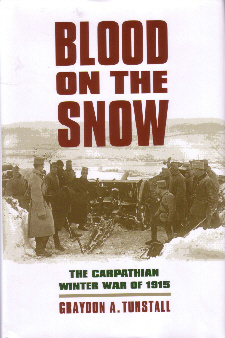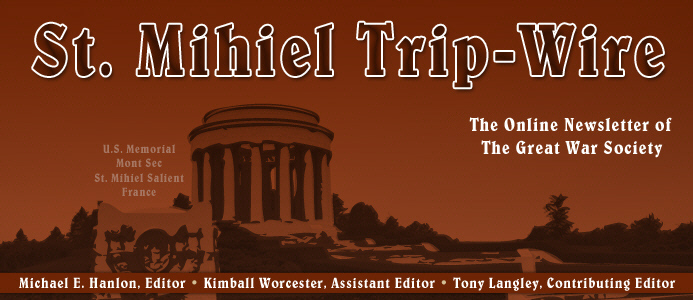

TRENCH REPORT: Your editor has a busy month of September ahead of him. On 8-12 September I will be at the annual seminar at the National WWI Museum in Kansas City. I hope you will drop by and say hello if you are attending. I'll be the lead-off speaker for the entire event; my presentation is titled: "The War by Summer 1918." Later in the month, 20-30 September, I'll be heading for Turkey to lead my second tour group to the Gallipoli battlefield. Consequently, the next Trip-Wire will not be hitting the news stands promptly on 1 October. I will publish, however. The disappointment expressed by some readers over my missing an issue here and there because of my schedule has been heard, and I will try to avoid that in the future if I can. MH
This Month's Internet Feature
The U-boat Campaign
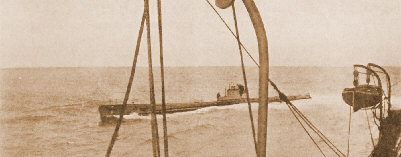
The Amazing Pre-WWI History of the Submarine
U-boats of WWI
Assassins of the Sea
Living Aboard a U-boat
Images & Film of the U-boat War
U-boat War in Political Cartoons
New at Our Own & Our Friends' Great War Websites
Click on Title or Icon to Access
|
A Great Educational Effort from St. Helena, California, High School:
Would you like to see a Website sponsored by an Academy Award winning film director? Reader Dale Thompson recommends Peter Jackson's:
At Great War Society Sites
At WFA-USA Sites
|

Question: Suppose the Armistice talks at Compiegne had broken down and fighting continued. What was the next Big Thing?
A combined French-American offensive in the Lorraine was to drive toward the Rhine through the Metz corridor. If successful it threatened to flank and even cut off much of the German army which was then deployed in Northern France. Initially it would have involved a repositioned French army under General Mangin and the newly formed U.S. Second Army attacking out of the reduced St. Mihiel Salient. Later, to the west, a re-vectoring U.S. First Army would join the assault from the right back (east side) of the Meuse. It was scheduled to begin 14 November, but Foch, who had belatedly become enthused about the idea, asked Pershing to begin attacking earlier. These operations that commenced 9 November are some of those last-minute attacks that are widely criticized as unnecessary given the negotiations under way at Compiegne.
|
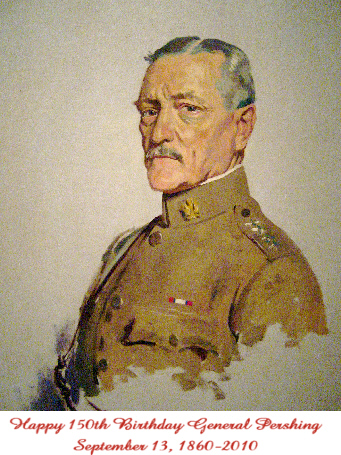
Portrait by Sir William Orpen, 1919
National Portrait Gallery, Washington DC
|
GREAT WAR 2010 EVENT CALENDAR
|
A World War I Event Calendar
We continue to add important events to our WWI Calendar. There is simply more information than we can display here on the Trip-Wire. It is available for all, however, by downloading it from our Website.
(download calendar as Word document)
|
WFA-USA & TGWS Joint Annual Seminar
September 10-11, 2010
National World War I Museum,
Kansas City, MO
(Program and News)
|
World War I Symposium
October 23, 2010
Henrico Theatre,
Henrico, VA 23075
(flyer and registration form)
|
Western Front Association
U.S. Branch Chapter Meetings
Check for Your Region
Regularly Updated (details)
|
Great War Society Monthly Chapter Meetings
Berkeley, San Francisco, and
Palo Alto, CA
Regularly Updated (details)
|
Upcoming Events at the National World War I Museum
Kansas City, MO
Regularly Updated (details)
|
Send additions/corrections for our master schedule:
Email Response
|
Sir Tom Stoppard is to pen a five-hour adaptation of the First World War for the BBC, the first time the author and dramatist has worked with the BBC in more than 30 years. Sir Tom, 73, has written the screenplay for the works of Ford Maddox Ford, who wrote Parade's End, a four-novel story set in England and the trenches of the Western Front. (link) Watch for more stories on this topic.
New WFA Subscription Program: The WFA in the UK is offering a new, lower-cost way to receive its premier journal Stand To!. Non-UK residents may now subscribe to three yearly issues of Stand To! for $40 (£26). Each illustrated issue is typically 56 pages long and dispatched in January, May, and September. To become a member of WFA Overseas Supporters and receive Stand To! go to the WFA - UK website at (link), and pay by credit card. Alternatively, you may send a check for $40 to WFA, Box 1918, Stockport, SK4 4WN, United Kingdom. Overseas Supporters do not become voting members of The Western Front Association. This is a subscription program only. Regular memberships in WFA-UK cost £35 per year.
Not New News But Encouraging Old News Reiterated: Peter Jackson really, really wants to make a film about Gallipoli. (link)

Our troops are more or less
finished.
Quartermaster General Erich von Ludendorff
After the Amiens Offensive of 8 August 1918
|
|
|
|
|
Page Two
|
|
|
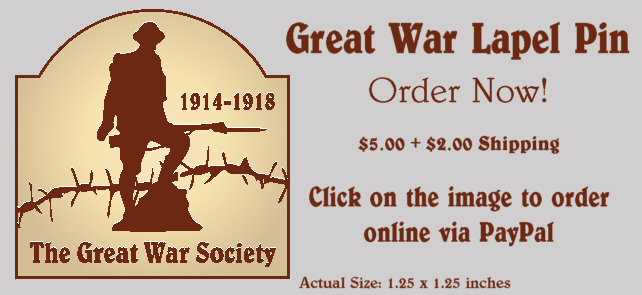 |
One View of Woodrow Wilson's Long Reach
|
(This is the most succinct and devastating critique of Woodrow Wilson's world view that I've run into. If someone has a comparably concise positive view, I'd be happy to present it as a response.)
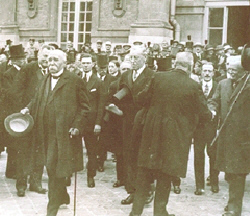
Clemenceau and Wilson |
Wilsonianism views human conflict as an expungeable byproduct of greed, militarism, oppression, secret diplomacy, and idolatrous worship of the balance of power. Wilson imagined a world born again as a democratic league practicing disarmament, free trade, arbitration, and collective security. Of those tenets, freedom of trade and open sea lanes remain vital interests that the U.S. Navy alone can defend. Wilson's "open covenants" did not survive the first week of his own conference, disarmament is the quickest way for the United States to lose its friends and encourage its enemies, and self-determination (as Wilson's secretary of state, Robert Lansing, predicted) is a Pandora's box that spews forth new horrors to this day. Finally, however much Wilson fudged the fact, the League of Nations implied an abridgment of the unilateralism that most Americans still cherish. Wilson's dream, as Henry Kissinger rightly notes, has even less of a chance in the era to come, since the ranks of the major powers may soon include Russia, China, India, Japan, Indonesia, Iran, and Nigeria [?], none of which has a tradition of Western jurisprudence.
In historical perspective, Wilsonianism may well come to be seen as the product of one narrow strain of turn-of-the-century, Anglo-American, Progressive, Protestant thought.
Walter A. McDougall
"Back to Bedrock: The Eight Traditions of American Statecraft,"
Foreign Affairs, Mar/Apr 1997
|
|
World War I Headlines
in the
21st Century
|
|
Christina Holstein's Sleeping Beauties
The Old Village Cemetery at
Esnes-en-Argonne
|
A traveller on the left bank of the River Meuse between Verdun and Varennes-en-Argonne (the scene of the arrest of Louis XVI and Marie Antoinette in 1791 as they tried to flee from France) passes through a number of villages that were totally destroyed during the First World War. In most cases they have been entirely rebuilt and only the use of some older stonework in the new buildings shows that there were houses and farms here at an earlier time.
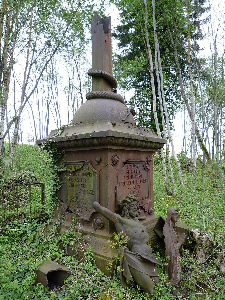
Central Monument
In one such village, however, there is a curious survivor from prewar days – the old village cemetery. It is in the village of Esnes, scene of such dreadful traffic jams during the Meuse-Argonne campaign of 1918 that no one could move in any direction for hours. The new cemetery is outside the village and the new road curves past it as it rises from the village to the plateau above. The old cemetery, however, is right in the middle of the village and it was only by taking a road that is normally closed to traffic that we found it at all.
|
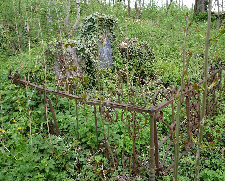 Graves
There were no civilians in this area between 1916 and the Armistice, and when the first inhabitants of Esnes returned after the war, they found that their cemetery had been badly shelled, the monuments were broken and the graves smashed. However, not wishing to lose all touch with their ancestors, they left things as they were and simply opened another cemetery elsewhere. Today the old graves are a poignant reminder of life in Esnes before the war, of families who never returned and of houses never rebuilt after the apocalyptic battle of 1916.
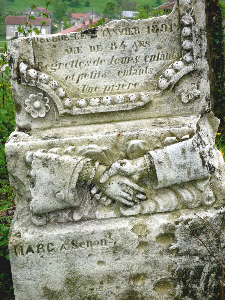 Partial Inscription |
|
|

|
French Artillery Watercolors
|
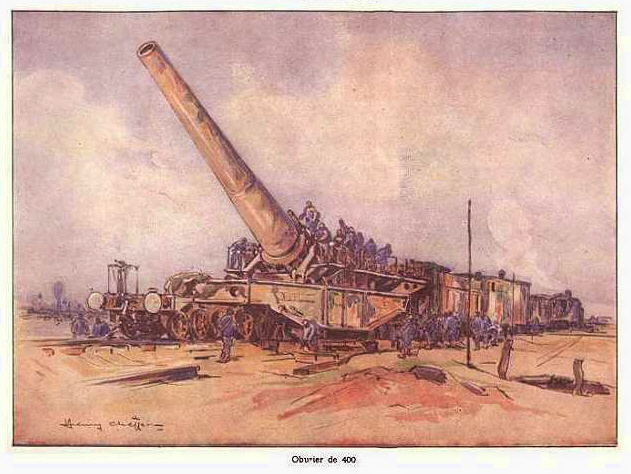
400mm Railroad Gun
French artist Henry Cheffer produced a series of dramatic watercolors of French artillery in action during the war. View the entire series at Tony's site: (link)
|
Click Here to Visit the Website of Our Contributing Editor Tony Langley
War in a Different Light
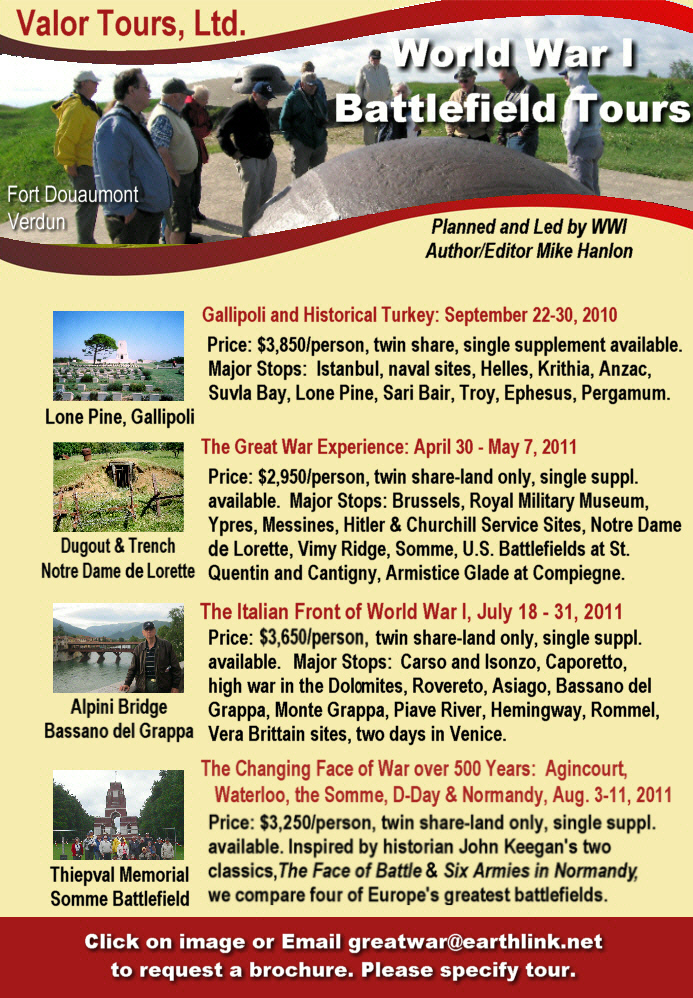
|
|
Subscribe to Our Online Magazine
|
|

|
|
|
Page Three
|
|
|
Great War Matrimonial News
|
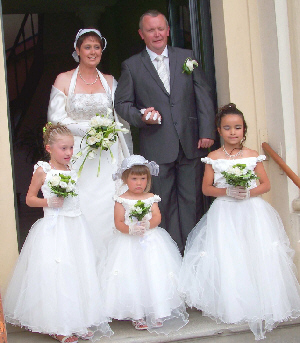
Murielle and Fred |
A World War I Wedding
in the Year 2010
Cupid recently let fly with some arrows along the Western Front and a World War I marriage of two of our friends ensued. The story: Our lovely bride, Murielle Bas, is the Assistant Superintendent of the U.S. Somme Cemetery at Bony, France. In the course of her duties, she became friends with Fred Castier, founder of the Arthur S. Tozar French/ American Friendship Museum in the Argonne Forest, as well as the in-country representative for the U.S. First Division Foundation and Museum. Well, apparently, Murielle found something even more interesting about Fred than their mutual interest in the Great War, and eventually (leaving out a lot of details), she accepted his proposal for marriage.
On 24 July 2010, Murielle and Fred were married at Nauroy, which is only four miles southeast of the cemetery at Bony. Joining the friends and family of the bride and groom were a number of dignitaries. On hand were former Command Sergeant Major Bill Ryan of the First Division and, from the American Battle Monuments Commission former superintendents Craig Rahanian, Joel Felz, and the new superintendent Walter Benjamin. It was a happy day for all. I know all our readers wish the best of happiness for the couple.
|
|
Specialized Reading List:
The Air Services Between the Wars
Contributed by Aero Historian & WFA-USA President Steve Suddaby
Regular readers know one of our favorite topics is how the lessons of the Great War were digested in the interwar period and influenced the conduct of the next world struggle. Here are some works covering the air services.
Cain, Anthony Christopher, The Forgotten Air Force: French Air Doctrine in the 1930s, Washington and London: Smithsonian Institution Press, 2002. Study of circumstances that changed the French air force from the world's most powerful at the end of 1918 to the force that was quickly and easily defeated by the Nazis in 1940. The lessons learned and mis-learned from WWI are a recurring theme in this study. Reasons for the 1940 defeat include: (1) the influence of the army in air force doctrine, making them a reactive force tied to the expected observation needs of the ground forces (based on the WWI static warfare experience) and (2) a propensity to stop building specialized aircraft, e.g., producing the 1934 Amiot 143 M bomber-fighter-reconnaissance plane which performed none of these tasks well.
Davis, Tami Biddle, Rhetoric and Reality in Air Warfare: The Evolution of British and American Ideas About Strategic Bombing 1914-1945, Princeton University Press, Princeton, 2002. One of the best books on the legacy of WWI bombing. Edwardian ideas of social Darwinism and early experience in Britain with riots caused the British to overestimate the stresses of bombing and its possible effectiveness. Normal cognitive processes kept them from changing this opinion in light of later experience and evidence.
Boyne, Walter J., The Influence of Air Power Upon History, Pelican Publishing Co., Gretna, LA, 2003. On page 133, quotes Prime Minister Baldwin that "the bomber would always get through". Also discusses another idea current in between-the-wars Britain: the vulnerability of the country to "the bolt from the blue" and "a knockout blow" by bombing attack.
|
|
Gas Warfare: Part 1
It is no secret that gas warfare was utterly inhuman. This series of French photos certainly documents that.
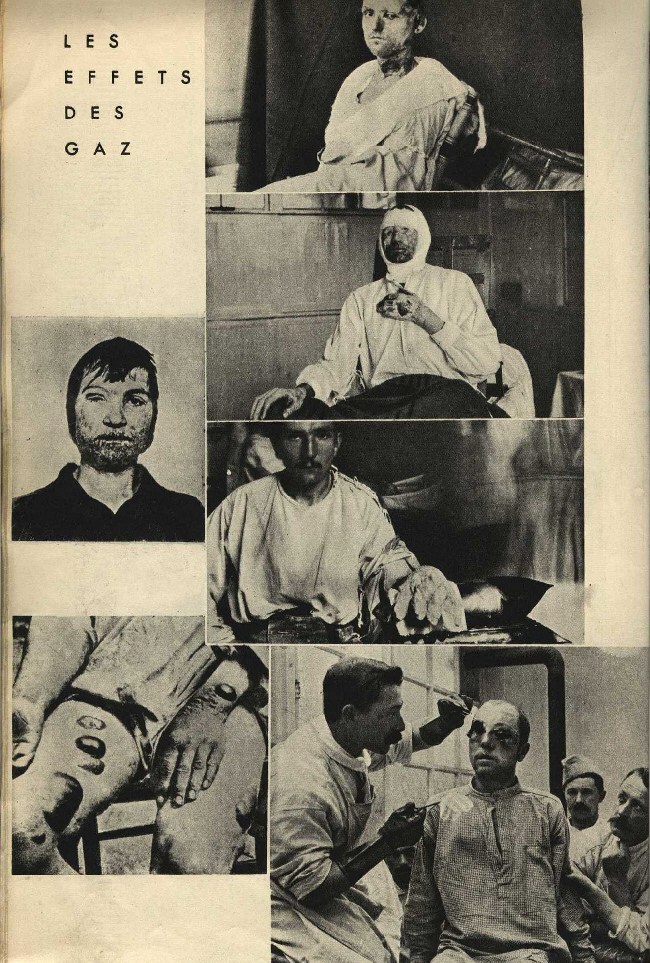
Effects of Gas of the Irritant Type, Probably Mustard Gas
Gas Warfare: Part 2
It is also, however, apparently a dirty secret that gas warfare was sometimes incredibly effective. Examples of this include the German response to the great British tank attack at Cambrai and the American (yes, you read that right) assault in the Argonne sector of 1 November 1918. Possibly the single most militarily effective use of gas ever was at the northern breakthrough sector of the October 1917 Battle of Caporetto. Below is an after-action account of a reconnaissance mission by an Austrian officer that captures both the inhumanity and effectiveness of the gas attack near Plezzo on the Caporetto battlefield.
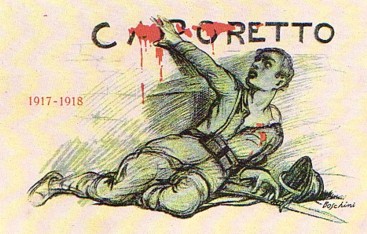
We had seen many terrible things, but what presented itself to our eyes on this occasion surpassed every
preceding spectacle and will stay in my memory forever. There in roomy and well-supplied shelters and
caverns were frozen some eight hundred men. All dead. A few, fleeing together, had fallen to the floor face
down. But the majority were bunched up near the walls of the shelters, rifles between their knees, uniform
and weapons intact. In a sort of barrack we found another forty bodies. Near the entrance were the officers,
the non-coms, and two telegraph operators with their headsets on, a writing pad in front of them, pencils in
hand. They hadn’t even tried to use their gas masks. They must have died without even being aware of what
was happening.
A little later we came to a cavern, whose entrance was camouflaged with sandbags. We opened a passage and
entered, shining the cone of light of our flashlight along the damp walls. At the end we saw a kind of
storehouse of weapons and clothing. In a corner deeper in the room there was tangle of bodies. From the
darkness there emerged some yellow streaks, faces a ghastly pallor. These for sure, had felt the blow of the
gas bombs.
Out! Away. It seemed as if we were suffocating. I grabbed Simic by the arm and we left.
When we were further away, we removed our gas masks and dried the sweat off our brows. My colleague
tried to smile to hide his dismay. We walked toward the battery without saying a word.
Fritz Weber, Austrian Army Artillery Officer
Translated by Leo Benedetti
Editor's Note:
In another document the chemical weapons that had been used were reported to be diphosgene and diphenylchloroarsine.
|
|
 |
Blood on the Snow: The Carpathian Winter War of 1915
by Graydon A. Tunstall
Reviewed by Len Shurtleff
|
Graydon (Jack) Tunstall has done a brilliant job of researching and presenting a readable analysis of the nearly forgotten series of icy mountain battles that destroyed the Austro-Hungarian Army and fatally weakened the Hapsburg monarchy. Massive frontal attacks, snow, freezing weather, lack of artillery ammunition, food, and medical care resulted in casualty rates exceeding those suffered at the Somme and Verdun. Outnumbered by better-led and better-armed Russian forces and crippled by poor leadership Austrian chief of Staff Conrad von Hötzendorf's three successive attempts to lift the siege of fortress Przemysl and forestall a Russian invasion of Hungary failed miserably. Conrad succeeded only in bleeding his armies white and leaving Vienna no alternative but to subordinate itself to Prussian political and military command. The Carpathian campaigns fought from January to March 1915 in mountainous terrain unsuitable for mass army maneuver paved the way for the brilliantly successful German attack at Gorlice-Tarnow, the greatest German victory of the war. These campaigns probably delayed the entry of Rumania, but did in no way deter Italy from joining the Entente in May 1915, forcing Austria-Hungary to spread its army, now weakened to a militia force, even thinner, drawing thousands of Germans to reinforce its crumbling fronts.
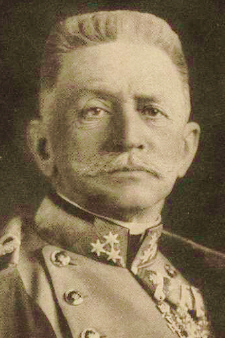
Conrad von Hötzendorf |
In his opening chapter, Tunstall recounts Conrad's determination to launch an early 1915 Carpathian offensive to blunt an anticipated Russian drive into Hungary. This decision was made despite poor winter weather, lack of artillery ammunition, and overwhelming Russian manpower superiority after irreplaceable Austro-Hungarian losses of 1.25 million men in 1914. Chapters two and three examine the first two Carpathian offensives, which opened on 23 January and 27 February, respectively. Chapter four discusses the third and final offensive, opened in late March to coincide with an attempt to break out from the besieged fortress of Przemysl culminating in a bloody Easter April battle. As Tunstall concludes, it was only the German victory at Gorlice-Tarnow that spared the Austro-Hungarian army from defeat and possible annihilation in the Carpathian theater.
Blood on the Snow: The Carpathian Winter War of 1915, Graydon A. Tunstall, Kansas, 2010, 320 pages, photos, maps, notes, bibliography, index, ISBN 978 0 7006 1720 3, $29.95 HB. The author is Professor of History at the University of South Florida, Executive Director of the History Honor Society Phi Alpha Theta, and a frequent speaker at WFA seminars.
|
|
|



















